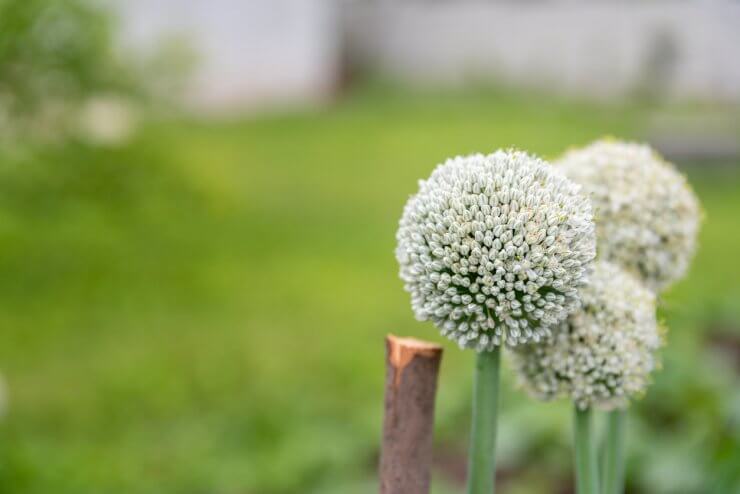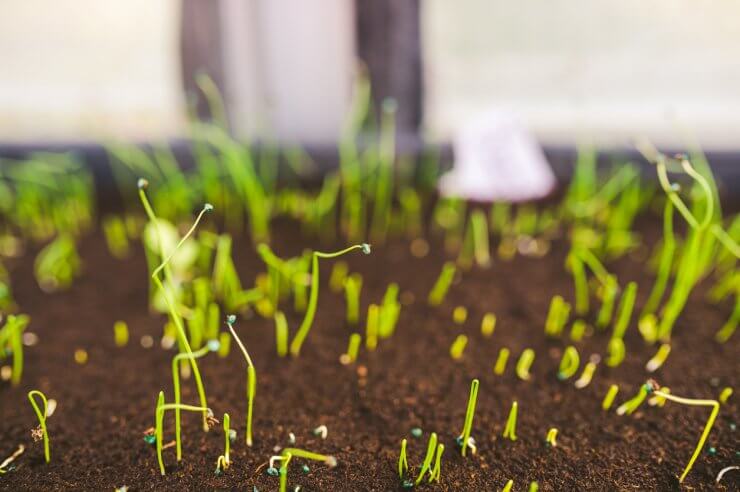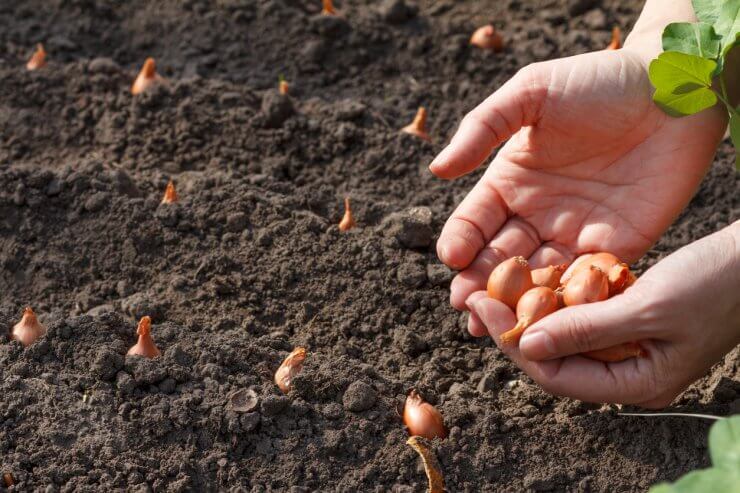
Onion flower going to seed
Getting your onion garden started begins with the choice of how to grow your plants—from seeds, seedlings, or small bulbs called sets. Check with your local garden center to see what they have available and what is likely to be most successful in your area. Starting from seed requires dedicated space for good growing conditions.
If you go with seeds, you’ll want to start them early, sowing them indoors in a warm, well-ventilated spot 10 to 12 weeks before you plan to plant them outside. Put seeds an inch apart in a container of seed starting mix and cover them with just a quarter inch of soil. Provide a reliable strong light source (like a grow light) for eight to 12 hours a day until the seedlings are 2 to 3 inches tall.
You’ll need to keep them moist (but not wet). It’s best to water your seedlings from the bottom. Get (or make) a seed starting tray with drainage holes that can sit inside another tray, and use that tray for watering. When your seedings are 2 to 3 inches tall and ready for transplanting, you’ll want to trim the roots to about a half inch long.
Hardening Off Seedlings

Onion seedlings
Before you just plunk your seedlings into the ground, you want to get them used to being outside; that’s called hardening off. Over the course of a week, put your seedling containers outside in a protected spot where they can enjoy the sunshine. Start with a few hours a day and work up to a full day. Then get ready to get planting!
Plant your young plants—bulb down, greens up—1 to 2 inches deep, 3 to 4 inches apart, in rows at least a foot apart—or up to 16 inches, depending on the variety you’re growing.
If you get sets, plan to plant them in the spring, as soon as your soil is workable. Planting sets is just like planting seedlings: bulbs down, greens up, planted and spaced at least an inch down and 3 inches apart. When in doubt, check your plant packaging or contact your local garden center or extension center.
Whatever method you choose, you need the right tools and supplies to plant and tend your onions, and you’ll want to have the right materials on hand for the end of the season when it’s time to harvest.
Besides your plants, necessary tools and supplies might include:
- Spade
- Trowel
- Pruning shears
- Gardening gloves
- Baskets or shallow boxes for transporting your harvest to a curing spot
Your baskets or shallow boxes will hold your onions during the curing process, so make sure they are broad and flat enough to give each onion its own space.
Planting Onions

Planting onion sets
If you live in an area where frost isn’t an issue, you could try starting your onion patch from seeds—but for most gardeners, you’d be better off planting sets instead. Onion sets are small onion bulbs that were planted densely the year before and never thinned out like you normally would do with seedlings. These hearty little bulbs are usually harvested at the end of summer and dried for at least four weeks. Then, come spring, they’re ready to plant in your garden.
Follow the guidelines of your hardiness zone for planting—you don’t want a surprise frost to kill off your plants. Whether you’re planting in containers, raised beds, or in a regular garden bed, be sure to give your seedlings or sets the right amount of space—plant them about 1 to 2 inches deep and 3 to 6 inches apart, depending on the variety you’re growing.
Some gardeners like to plant their seedlings in little groups or two or three together. In some cases, the plants thrive that way. You’ll have to keep an eye on your own onions to see if that approach works for you. You can plant some together, and space others out.
Have you tried growing onions from seeds, transplants, or sets? Which method do you prefer—and why? Please tell us how you get your onion plants started.


 Previous
Previous


I have heard that cutting the green tops off to about 4 inches, just as the onions begin to flower, causes the energy to go into the onion bulb. Is this true, or just an urban legend?
To have fresh onion tops in winter I buy green onions – cut off the bottom 1.5 to 2 inches and plant in a planter and as the tops regrow I can have green onion tops all winter – you can do similarly with celery and leaf lettuce.
Donna,
Thank you so much for sharing your experience with regrowing vegetables from scraps. Please check out this post for some additional ideas. https://foodgardening.mequoda.com/daily/vegetable-gardening/easy-ways-to-start-growing-vegetables-from-scraps/